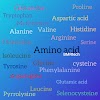Tryptophan Amino Acid
Introduction
It is an essential amino acid. Tryptophan contain α-amino acid that is used in the biosynthesis of proteins. Tryptophan contains α-amino group and α-carboxylic acid group. A side chain indole, making it a non-polar aromatic amino acid. It is essential in humans, meaning that the body cannot synthesize it and it must be obtained from the diet. Tryptophan is also a precursor to the neurotransmitter serotonin, the hormone melatonin, and vitamin B3. It is encoded by the codon UGG.
Tryptophan is a zwitterion at physiological
pH where the amino group is protonated and the
carboxylic acid is deprotonated.
History-
Tryptophan was first isolated in 1901, from the milk protein casein, by Sir Frederick Gowland Hopkins. By feeding mice a diet devoid of tryptophan, he was later able to demonstrate that it is essential for animal life. As well, he demonstrated that tryptophan and several other amino acids cannot be manufactured in the body and must be obtained from the diet. He was awarded the Nobel Prize for his discovery of vitamins, produced by amino acids like tryptophan.
Properties :-
Chemical formula :- C11H12N2O2
Molar mass :- 204.229 g·mol−1
Solubility in water :- Soluble: 0.23 g/L at 0 °C, 11.4 g/L at 25 °C, 17.1 g/L at 50 °C, 27.95 g/L at 75 °C
Thermodynamic data :- Phase behaviour (solid–liquid–gas)
Structure-
Sources-
Tryptophan is present in most protein-based foods or
dietary proteins. It is particularly plentiful in chocolate, oats,
dried dates, milk, yogurt, cottage
cheese.
Contrary to the popular belief that cooked turkey contains an abundance of tryptophan. The tryptophan
content in turkey is typical of poultry
Biosynthesis-
It is an essential amino acid, tryptophan is not
synthesized from simpler substances in humans and other animals, so it needs to
be present in the diet in the form of tryptophan-containing proteins. Plants
and microorganisms commonly
synthesize tryptophan from shikimic acid or anthranilate, anthranilate
condenses with phosphoribosylpyrophosphate (PRPP), generating pyrophosphate as a by-product. The ring of the ribose moiety is
opened and subjected to reductive decarboxylation, producing
indole-3-glycerol phosphate; this, in turn, is transformed into indole. In
the last step, tryptophan synthase catalyzes the formation of tryptophan from indole and the
amino acid serine.
Function-
Amino acids, including tryptophan, are used as building
blocks in protein biosynthesis.
Proteins are required to sustain life.
Many animals (including humans) cannot synthesize
tryptophan: they need to obtain it through their diet, making it an essential
amino acid.
Tryptophan is among the less common amino acids found in
proteins, but it plays important structural or functional roles whenever it
occurs.
Tryptophan and tyrosine residues play special roles in
"anchoring" membrane proteins within
the cell membrane.
Tryptophan, among with other aromatic amino
acids, is also important in glycan-protein
interactions.
SUBSCRIBE FOR MORE INFORMATION........!








0 Comments